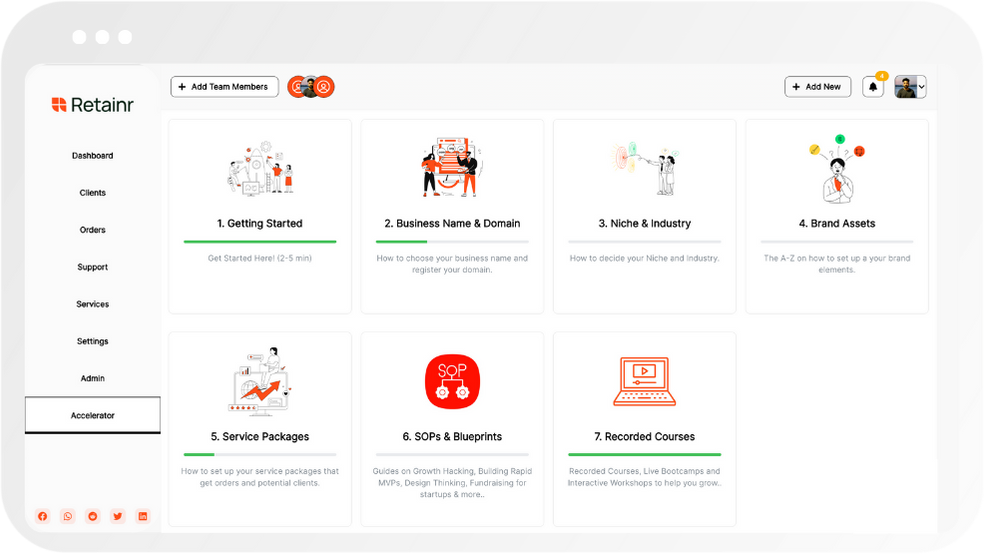
How to Streamline and Automate Your Business Processes
Build with Retainr
Sell your products and services, manage clients, orders, payments, automate your client onboarding and management with your own branded web application.
Get Started1. What is meant by streamlining and automating business processes?
Understanding Streamlining and Automating Business Processes
Streamlining and automating business processes are innovative ways to enhance efficiency, reduce errors and simplify workflows within an organization. Many enterprises are actively seeking such strategies to stay ahead in the competitive business world. Let's delve into what these terms mean.
Streamlining involves the simplification of tasks or business processes with the goal of improving efficiency and productivity. In essence, it's all about removing unnecessary steps, reducing redundancy, and using the right tools or processes to get tasks done faster and more efficiently. Consider the following examples:
- Digitizing paperwork to eliminate the need for physical forms.
- Eliminating multiple approvals in decision-making processes.
- Utilizing project management tools to track progress and assign tasks.
On the other hand, Automation is a subset of streamlining that involves using technology to execute recurring tasks or processes in a business where manual effort can be replaced. It helps businesses save time and money, increase accuracy and efficiency. Here are some examples of automated processes in a business context:
- Using software for payroll management instead of manually calculating employee wages.
- Implementing customer relationship management (CRM) systems to automate marketing and sales interactions.
- Deploying automated email marketing systems for regular communication with customers.
Streamlining and Automation: A Combined Approach
The convergence of both streamlining and automation entails that businesses not only simplify their processes but also leverage technology to perform tasks with minimal human intervention. This ultimately increases efficiency, reduces costs, boosts productivity, and enables constant operation without fatigue or errors associated with manual work. This strategic approach is beneficial irrespective of the industry or business size. A systematic flow of streamlined and automated processes might look like this:
| Step | Streamlining | Automation |
|---|---|---|
| 1 | Eliminate unnecessary steps | Identify tasks that require automation |
| 2 | Combine activities where possible | Select suitable automation tools |
| 3 | Rearrange tasks for better workflow | Implement and test automation tools |
2. Why is it important to streamline and automate business processes?
Benefits of Streamlining and Automating Business Processes
There are several reasons why it's important to streamline and automate business processes. Firstly, it leads to time-saving as automation can handle repetitive tasks faster and more accurately than humans. Secondly, it allows staff to focus on more complex tasks and strategic initiatives, increasing productivity and efficiency. Lastly, automation reduces the risk of errors, ensuring data integrity and quality control. Here is a brief overview:
- Time-saving: Automated systems can perform tasks faster and with increased accuracy, freeing up employees to focus on other responsibilities.
- Increased productivity: Employees are able to focus on strategy and creativity rather than repetitive tasks.
- Error reduction: Automated systems minimize the risk of human errors and help maintain high-quality data and services.
The Impact on Businesses
Notably, the impact of streamlining and automating business processes extend beyond operations and personnel. This strategic step drastically improves the client and customer experience, therefore increasing customer satisfaction and loyalty. Moreover, it facilitates a more efficient use of resources, leading to cost savings. The following table exhibits the parameters affected by automation and streamlining and their manifestations:
| Parameter | Impact |
|---|---|
| Customer Experience | Steady and prompt service delivery driven by automation results in customer satisfaction and loyalty. |
| Resource Utilization | With the decrease in manual labor due to automation, resources can be allocated more efficiently, leading to cost savings. |
The Future Scope
Ultimately, in an increasingly digital and competitive business landscape, streamlining and automation of business processes are no longer options, but necessities. Companies that want to stay ahead will need to leverage automation to improve their service levels, scale their operations and ensure their survival in the market.
3. What are the key steps in streamlining and automating a business process?
Identification of Business Processes
The first critical step in streamlining and automating your business process is the identification of your current business processes. You need to conduct a thorough analysis of your business processes which typically includes:
- Gathering relevant data, such as time, costs, and resources related to each process
- Mapping out your current workflow, identifying bottlenecks, redundancies, or inefficiencies
- Defining your desired outcomes for each process, such as reduced time, cost, or improved quality
Plan and Design Process Changes
Having recognized the areas that need improvement, the second step is to plan and design process changes. Here's what this phase entails:
- Strategically eliminating unnecessary or redundant processes
- Combining similar or related processes to reduce complexity
- Designing and implementing automated processes where feasible
Implement, Review, and Optimize
The final step incorporates the implementation, review, and optimization of the revamped processes. These steps ensure that the changes have the anticipated impact and can be adjusted if necessary. The table below exhibits the relevant activities and methods.
| Activities | Methods |
|---|---|
| Implement Changes | Use automated tools, train staff, communicate changes |
| Review Outcomes | Monitor the process, collect feedback, analyze data |
| Optimize Processes | Make necessary adjustments, implement continual improvement initiatives |
4. How can the streamlining of business processes improve efficiency?
Increased Efficiency through Streamlining
When it comes to improving efficiency, the streamlining of business processes plays an indispensable role. This approach minimizes unnecessary steps, enhances communication, and accelerates decision-making. The crucial benefits that significantly contribute to improved efficiency are:
- Elimination of Redundancy: By streamlining processes, duplicate efforts caused by miscommunication or disjointed systems can be prevented, thus freeing up time.
- Improved Decision-Making: A streamlined process usually provides a clearer understanding of each role and responsibility, which can help managers make critical decisions faster.
- Increased Productivity: Streamlining often automates manual tasks, freeing up employees to focus on more value-adding tasks that require human intellect.
- Better Quality Control: A systematic approach allows for a better check and balance system, thus improving quality control and minimizing errors.
Evaluating Efficiency Improvements
By monitoring certain metrics before and after the implementation of streamlined processes, a business can evaluate the improvement in efficiency. An example of these key metrics to measure efficiency improvements might include:
| Metric | Description |
|---|---|
| Time Taken | Measuring the time taken for process completion, pre and post streamlining. |
| Error Rate | Comparing the rate of errors or process deviations before and after streamlining. |
| Employee Satisfaction | An increase in employee satisfaction can be an indicator of successful streamlining, as easier processes translate to happier employees. |
Anticipating Potential Hurdles
While streamlining business processes can greatly improve efficiency, it's important to anticipate potential hurdles. The potential challenges encountered during this process might include:
- Inadequate Training: Without proper training, employees might have trouble adapting to new procedures, causing a temporary decrease in productivity.
- Resistance to Change: Some employees may resist changing established practices, impeding the streamlining process.
- Excessive Streamlining: Over-optimizing can potentially remove necessary checks and balances, which may lead to overlook errors or oversights.
5. What tools or software are best for automating business processes?
Top Business Process Automation Tools
There are several tools and software available today that are designed for automating business processes. Here are some of the top ones:
- Microsoft Power Automate: This tool, formerly known as Flow, can connect to multiple applications to automate tasks and workflows seamlessly across them.
- Zapier: Zapier is a popular automation tool that allows you to connect and automate tasks between thousands of different apps. It is particularly helpful for small businesses.
- Blue Prism: This is an intelligent automation platform that can be used to automate complex, end-to-end operational activities.
Top Software for Business Automation
On the other hand, there are also software specifically designed with a broader scope for business process automation. These include:
| Software | Advantages |
|---|---|
| Jira | Leading software platform for IT project management and issue tracking. Its flexibility allows for comprehensive business process automation. |
| Kissflow | Allows non-technical staff to design and implement automated process workflows. |
| ProcessMaker | Offers a range of tools for design, automation, and review of business process workflows. |
Choosing the Right Tool or Software
While these tools and software provide powerful ways to streamline and automate business processes, one size doesn’t fit all. When choosing the right tool or software for your business, consider the type of processes you want to automate, the complexity of the tasks, your budget, and your technical capacity. A simple application for repetitive tasks might suffice for smaller businesses, while larger enterprises with complex needs may benefit from comprehensive software suites. Test different tools and software, and select the one that best fits your needs and your organization’s workflow.
6. How can automation help in reducing the cost of business operations?
Lowering Operational Costs Through Automation
Automation plays a crucial role in cost reduction in today's businesses. By automating manual tasks, companies can significantly reduce the effort, time, and resources required in their operations, leading to substantial cost savings. Here's how automation aids in lowering business costs:
- Reduced Labor Costs: Replacing manual processes with automated systems means fewer human resources are required, leading to substantial savings in salaries, benefits, and other related costs.
- Improved Efficiency: Automation enhances operational efficiency by enabling businesses to accomplish tasks faster and with fewer mistakes, thus minimizing waste and rework costs.
- Increased Production Volume: Automated systems can operate 24/7, thereby increasing production capacities and revenues without additional labor costs.
Quantifying Cost Reduction through Automation
Understanding the cost-benefit ratio of business automation can help companies make more informed decisions. The following table offers an illustration of potential cost savings.
| Area | Before Automation | After Automation | Savings |
|---|---|---|---|
| Labor Costs | $100,000 | $60,000 | $40,000 |
| Efficiency Losses (Rework, Waste) | $30,000 | $10,000 | $20,000 |
| Increased Production Volume | Not applicable | Higher revenue | Directly relates to revenue increase |
Identifying Areas for Automation
Not every business process is suitable for automation. For optimal cost reduction, it's crucial to identify the areas where automation can deliver maximum benefit. Key considerations may include:
- High-volume, repetitive tasks: Processes involving high-volume, repeatable tasks are prime candidates for automation.
- Tasks prone to human error: Automation can minimize mistakes in activities where precision is vital, such as data entry and calculations.
- Customer service: Automated chatbots and Customer Relationship Management systems can deliver efficient, cost-effective customer support round the clock.
7. Can automation help in the reduction of errors in business processes?
Automation and Reduction of Errors
Automation plays a critical role in reducing errors in business processes. These errors, often the result of manual entries or human oversight, influence the efficiency of tasks and the overall quality of work done. Here's how automation assists in error reduction:
- Enhanced Accuracy: Unlike humans, machines do not make errors when provided with the same input. They also maintain consistency and precision throughout business processes, ensuring high-quality outcomes every time.
- Improved Compliance: Automation allows businesses to incorporate regulatory and compliance standards into their workflows. It ensures that these guidelines are followed concoctly, mitigating risks of noncompliance due to human error.
- Greater Reliability: Automation offers real-time monitoring of business processes, enabling imminent error detection and correction. This facilitates a better workflow as tasks get completed accurately at the set time.
Error Reduction through Automation: An Example
The table below showcases how automation reduces errors in a simple process like data entry:
| Process | Without Automation | With Automation |
|---|---|---|
| Data Entry | Manual data entry involves a high risk of typos and other errors, especially with lengthy or complex information. | Automated data entry, often via data import or syncing with other systems, eliminates the risk of human mistakes and ensures accuracy. |
Conclusion
Without a doubt, automation can help businesses significantly reduce errors in their processes, increase efficiency, and enhance overall productivity. As companies rely more and more on data, the accuracy of this information becomes crucial. Thus, through automation, businesses can foster a working environment where precision isn't compromised, contributing to substantial improvement in their bottom line.
8. How long does it typically take to automate a business process?
Factors Influencing Automation Time
The time it takes to automate a business process is influenced by a variety of factors. These can be grouped into three main categories:
- Complexity of Process: If the process involves multiple steps, people, or systems, it will take longer to automate. This is because it requires more time to analyze, design, and implement the automation.
- Technology Used: Different automation technologies have different capabilities and learning curves. For example, simple task automation can be achieved quickly using Robotic Process Automation (RPA), but more complex processes may need Business Process Automation (BPA) software or Artificial Intelligence (AI), which could take longer.
- Skills and Experience: A team with prior experience in automation can complete the project faster. They are able to anticipate challenges, streamline the process, and troubleshoot issues effectively.
Typical Automation Timelines
Based on the above factors, here is a rough estimation of the typical timeline for a business process automation project:
| Process Type | Estimated Time |
|---|---|
| Simple process (using RPA) | 1 to 4 weeks |
| Moderate process (using BPA) | 1 to 3 months |
| Complex process (using AI) | 3 to 6 months |
Strategies for Speeding Up Automation
While the above timelines are estimates, businesses can follow strategies to expedite their automation projects:
- Invest in Training: Equip your team with appropriate skills and knowledge about the automation technology.
- Simplify the process: Break down complex processes into simpler tasks for easy automation.
- Use Agile Methodologies: Recurring cycles of development and testing allow for faster course correction and process optimization.
- Partner with experienced vendors: They provide expertise and resources which accelerates the automation process.
9. What are the potential risks or drawbacks of automating business processes?
Potential Risks of Automating Business Processes
When automating business processes, there may be several potential risks or drawbacks that need to be considered. First is the disruption in business operations. For companies that have been running in traditional ways for years, introducing automation can be a daunting task. It may cause temporary disruption to the workflows as employees need time to adjust to the new systems. This can lead to a decline in productivity until the new processes are fully incorporated.
- Reduced Flexibility - Automating a process makes it consistent, which can limit flexibility. If changes or adjustments are needed, they can be more difficult and time-consuming to implement.
- High Initial Costs - The adoption and integration of automation technology can be expensive. The return on investment may take time and is not always guaranteed.
- Data Security Risks - Automated systems often require sharing sensitive information with software providers, increasing the potential risk of data breaches.
Drawbacks of Automating Business Processes
Automating business operations also has its drawbacks. While automation can enhance efficiency and accuracy, it can also lead to job loss and employee resentment. Automation can reduce the need for human intervention in many tasks, leading to layoffs. Furthermore, employees may resist the change, affecting morale and productivity.
| Drawbacks | Description |
|---|---|
| Job Loss | Automation reduces the need for human intervention in tasks, potentially leading to layoffs. |
| Employee Resentment | Some employees may see automation as a threat to their jobs and resist the change, leading to decreased morale and productivity. |
| Lack of Personal Touch | Automated services can sometimes lack the personal touch of human interaction, which can negatively affect customer satisfaction levels. |
10. How to ensure that all employees are on board with the automation process?
Communication and Training
One critical step in ensuring that all employees are on board with the business process automation is through effective communication and training. Providing them with a clear understanding of the changes, the reason behind it, and how it will affect their individual roles can help alleviate any concerns. Start by explaining the benefits of automation such as improved efficiency, error reduction, and the ability to focus more on strategic tasks. It is also important to discuss the changes in their workflow and provide user-friendly manuals or tutorials for a smoother transition. Training sessions should also be conducted to offer hands-on experience with the new system.
Seek Employee Feedback
To further encourage employee buy-in, it's beneficial to seek their feedback during the planning and implementation stages. A two-way dialogue can help identify possible issues that you may not have considered and allow employees to feel involved in the process. You can organize brainstorming sessions for suggestions, conduct surveys to gauge their responses, and create an open-door policy for any questions or concerns. Acknowledging and addressing their feedback can contribute to a more positive attitude towards automation.
Implement Gradual Changes
Rapid and drastic changes can lead to confusion and resistance among employees. Hence, a gradual implementation approach can be more effective. Start by introducing elements of automation to small projects or departments. Monitor the results, make necessary adjustments, and then roll out the changes throughout the organization as confidence and familiarity grow. Below is a suggested gradual implementation process:
| Phase | Steps |
|---|---|
| Phase 1 | Introduction of the automation concept and benefits |
| Phase 2 | Initial implementation in a single project or department |
| Phase 3 | Evaluation of results and adjustments |
| Phase 4 | Gradual rollout to the rest of the organization |
Conclusion
Streamlining and Automating Your Business Processes
In today's dynamic business environment, efficiency is king. Automating and streamlining your business processes can not only save time and resources but also improve accuracy and enhance productivity. This article provides insights into how you can make your business operations smoother with automation.
The Power of Automation
To stay relevant and competitive, businesses need to embrace automation. The automation of routine tasks can free up more time for your team to focus on core activities. Additionally, automation can help to improve customer service, streamline communication, and expedite the decision-making process.
How to Streamline and Automate Your Business
Firstly, to streamline and automate your business, you need to have a clear understanding of your business processes. Once you have identified the repeated tasks, you can start implementing the right tools to automate them. It's also crucial to train your employees to use these tools properly and to track and measure the outcomes.
Presenting Retainr.io
One such tool that can simplify your business operations and boost your efficiency is Retainr.io. This whitelabel software enables you to sell, manage clients, orders, and payments through your own branded app.
Why Choose Retainr.io?
By choosing Retainr.io, you are effectively giving your business a competitive edge. It streamlines your operations by allowing you to manage all your client interactions, sales, and payments in one place. Its intuitive and user-friendly interface ensures a seamless transaction process for your clients.
Conclusion
Streamline and automate your business processes with Retainr.io and enjoy benefits like increased productivity, improved accuracy, and resource optimization, among many others.
Boost Your Agency Growth
with Retainr Accelerator
Uncover secrets, strategies, and exclusive blueprints to take your agency's growth to the next level — from marketing insights to effective presentations and leveraging technology.

SOPs, Cheatsheets & Blueprints
Leverage 50+ SOPs (valued over $10K) offering practical guides, scripts, tools, hacks, templates, and cheat sheets to fast-track your startup's growth.
Connect with fellow entrepreneurs, share experiences, and get expert insights within our exclusive Facebook community.
.jpg)

Join a thriving community of growth hackers. Network, collaborate, and learn from like-minded entrepreneurs on a lifelong journey to success.

Gain expertise with recorded Courses, Live Bootcamps and interactive Workshops on topics like growth hacking, copywriting, no-code funnel building, performance marketing and more, taught by seasoned coaches & industry experts.

.jpg)

.jpeg)


